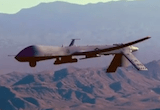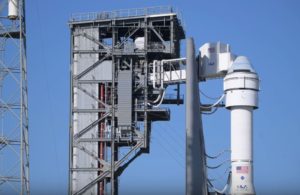‘NOVA’: The ‘Next Generation’ of Drone Surveillance
A new drone-mounted surveillance camera, chillingly described as the "Wide Area Persistent Stare," can see and record, all at once, virtually everything happening at ground level in a medium-sized city.A new drone-mounted surveillance camera, known as the "Wide Area Persistent Stare," can see and record virtually everything happening at ground level in a medium-sized city.
The PBS show “NOVA” is funded in part by arch-conservative David Koch and defense companies like Lockheed Martin. It often smacks of TED-talk greasiness and rarely criticizes its subjects. But the series’ latest installment on unmanned aerial vehicles, “Rise of the Drones“, appears to contain new, genuinely valuable revelations.
Those unfamiliar with UAVs will find a concise summary of the current, publicly known state of play as well as a brief history of their development. What appears to be new are the details of a panoramic camera called Argus developed by Britain-based BAE Systems, the third-largest defense contractor in the world.
“Today we’ve developed sensors that can watch, with an all-seeing eye, and see an area about the size of a small city. All at one time,” said David Deptula, a lieutenant general in the U.S. Air Force.
At 1.8 billion pixels, Argus is the world’s highest-resolution camera. For comparison, a quick Google search suggests that the next highest-resolution camera, available to professionals, is a Swedish-made Hasselblad, which clocks in at 200 million pixels.
The cameras currently mounted on armed predator drones are limited. Although operators can zoom in on precise locations, the act is like looking through a soda straw. The effect is that operators often have a poor sense of what is going on outside their narrow field of vision, even at altitudes of 20,000 feet.
Argus makes the predator camera obsolete. “Also known as ‘Wide Area Persistent Stare,’ Argus is the equivalent of having up to 100 predators look at an area the size of a medium-sized city at once,” “NOVA” says. This is done by stitching together streams captured by a curved mosaic of 368 lens chips into one fluid video. Standing at a monitor, an operator can zoom in on specific areas anywhere within the image, opening up to 65 windows that contain magnified views while maintaining the larger context.
From an altitude of 17,500 feet, Argus can see an object 6 inches off the ground, and automatically identifies everything that moves. Its recordings can be stored at a capacity equivalent to 5,000 hours of high-definition footage and are instantly retrievable at every level of magnification.
“NOVA” indicates these cameras could one day be mounted on a fleet of solar-powered craft capable of staying aloft for five years at a time. “We would like Argus to be over the same area 24 hours a day, seven days a week,” BAE designer Yannis Antoniadis said.
— Posted by Alexander Reed Kelly.
‘NOVA’:
Watch Rise of the Drones on PBS. See more from NOVA.
Your support matters…Independent journalism is under threat and overshadowed by heavily funded mainstream media.
You can help level the playing field. Become a member.
Your tax-deductible contribution keeps us digging beneath the headlines to give you thought-provoking, investigative reporting and analysis that unearths what's really happening- without compromise.
Give today to support our courageous, independent journalists.








You need to be a supporter to comment.
There are currently no responses to this article.
Be the first to respond.